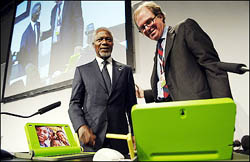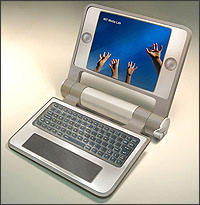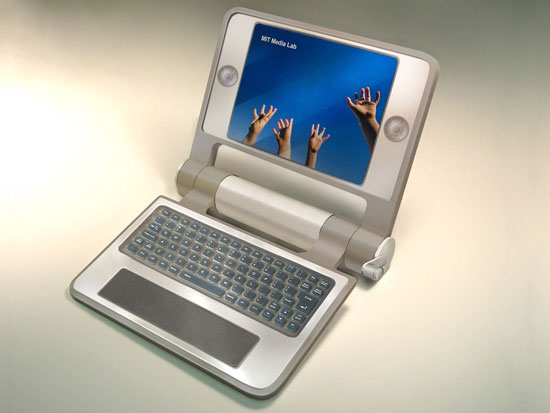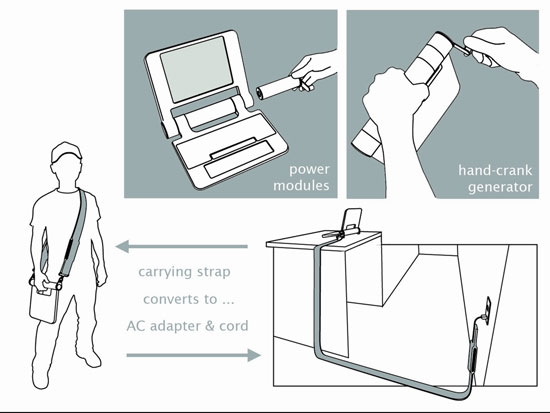
That’s now the name of the $100 laptop, or one laptop per child. Fits up to six children inside.
Why is it that the publicity images of these machines are always like this? Ghostly showroom white and all the kids crammed inside. What might it mean? I get the feeling that we’re looking at the developers’ fantasy. All this well-intentioned industry and aspiration poured into these little day-glo machines. But totally decontextualized, in a vacuum.

This ealier one was supposed to show poor, brown hands reaching for the stars, but it looked more to me like children sinking in quicksand.
Indian Education Secretary Sudeep Banerjee, explaining last month why his country would not be placing an order for Negroponte’s machines, put it more bluntly. He called the laptops “pedagogically suspect.”
ADDENDUM
An exhange in the comments below made me want to clarify my position here. Bleak humor aside, I really hope that the laptop project succeeds. From the little I’ve heard, it appears that the developers have some really interesting ideas about the kind of software that’ll go into these things.
Dan, still reeling from three days of Wikimania earlier this month, as well as other meetings concerning OLPC, relayed the fact that the word processing software being bundled into the laptops will all be wiki-based, putting the focus on student collaboration over mesh networks. This may not sound like such a big deal, but just take a moment to ponder the implications of having all class writing assignments being carried out wikis. The different sorts of skills and attitudes that collaborating on everything might nurture. There a million things that could go wrong with the One Laptop Per Child project, but you can’t accuse its developers of lacking bold ideas about education.
Still, I’m skeptical that those ideas will connect successfully to real classroom situations. For instance, we’re not really hearing anything about teacher training. One hopes that community groups will spring into action to help develop and implement new pedagogical strategies that put the Children’s Machines to good use. But can we count on this happening? I’m afraid this might be the fatal gap in this otherwise brilliant project.
Category Archives: Negroponte
the year in ideas
In developed nations, and in the US in particular, high-speed wireless access to the Internet is a given for the affluent and an achievable possibility for most. In the rest of the world, owning a computer is a dream for a community, and a fantasy for the individual. At this moment, away in the central mountains of Colombia, I am virtually disconnected from the world, though quite connected to the splendor of nature. I’m writing this relying on uncertain electricity that, if it fails, will be backed up by a gas generator that will keep food fresh and beer cold, the hell with the laptop. Reading one of last week’s Medellín’s newspapers, I was surprised to see news of the advent of the BlueBerry as a technological advance that will reach the city in early 2006. Medellín is a booming, sophisticated Third World city of more than 3.5 million people. This piece of news made clearer for me, more than ever, how in the US we take technology for granted when, in fact, it is the domain of only a small minority of the world. This doesn’t mean that the rest don’t need connectivity, it means that if they are being pushed to play in the global monopoly game, they must have it. From that perspective, I bring the New York Times Magazine’s fifth edition of The Year in Ideas” (12/11/2005.) As always, it examines a number of trends and fads that, in a way or another, were markers of the year. Considering the year at the Institute and its pursuit of the meaningful among myriad innovations, I’ll review some of the ideas the Times chose, that meet the ones the Institute brought to the front throughout the year. Beyond the noteworthy technological inventions, it is the human contribution, the users’ innovative ways of dealing with what already exists in the Internet, which make them worth reflecting upon.
The political power of the blogosphere is an accepted fact, but it is the media infrastructure that passes on what is said on blogs what has given the conservatives the upper hand. Even though Howard Dean’s campaign epitomized the power of the liberal blogosphere, the so called “Net roots” continue to be regarded as the terrain of young people with the time in their hands to participate in virtual dialogue. The liberal’s approach blogs as a forum to air ideas and to criticize not only their opponents but also each other, differs greatly from that of the conservatives’. They are not particularly interested in introspection and use the Web to support their issues and to induce emotional responses from their base. But, it is their connection to a network of local and national talk-radio and TV shows what has given exposure and credibility to the conservative blogs. Here, we have a sad, but true, example of how it is the coalescence of different media what matters, not their insular existence.
The news media increasingly have been using the Web both as an enhancer and as a way to achieve two-way communications with the public. An exciting example of the meeting of journalism and the blog is the New Orleans Times-Picayune. Before Katrina hit the city, they set up a page on their Web site called “Hurricane Katrina Weblog.” Its original function was supplemental. However, when the flood came and the printed edition was shut down, the blog became the newspaper. Even though the paper’s staff kept compiling a daily edition as a download, the blog was brimming with posts appearing throughout the day and readership grew exponentially, getting 20 to 30 million page views per day. The paper continued posting carefully edited stories interspersed with short dispatches phoned or e-mailed to the newspaper’s new headquarters in Baton Rouge. In the words of Paul Tough, “what resulted was exciting and engrossing and new, a stream-of-consciousness hybrid that combined the immediacy and scattershot quality of a blog with the authority and on-the-scene journalism of a major daily newspaper.”
Joshua M. Marshall, editor of the blog Talkingpointsmemo.com, decided to ask his readers to share their knowledge of the ever spreading Washington scandals in an effort to keep abreast of news. He called his experiment “open-source investigative reporting.” Marshall’s blog has about 100,000 readers a day and he saw in them the potential to gather news in a nationwide basis. For instance, he relied on his readers’ expertise with Congressional ethics code in order to determine if Jack Abramoff’s gifts were violations. What Marshall has come up with is a very large news-gathering and fact-checking network, a healthy alternative to traditional journalism.
Podcasting has become another alternative to broadcasting which provides the ability to access audio and video programs as soon as they’re delivered to your computer, or to pile them up as you do with written media. Now, through iTunes, we are experiencing the advent of homemade video postcasts. Some of them have already thousands of viewers. Potentially, this could become the next step of community access television.
The mash-up of data from different web sites has gained thousands of adepts. One of the first ones was Adrian Holovaty’s Chicagocrime.org, a street map of Chicago from Google overlaid with crime statistics from the Chicago Police online database. Following this, many people started to make annotated maps, organizing all sorts of information geographically from real-estate listings to memory maps. The social possibilities of this personal cartography are enormous. The Times brings Matthew Haughey’s “My Childhood, Seen by Google Maps,” as an example of an elegant and evocative project. If we think of the illuminated maps that expanded the world and ignited the imagination of many explorers, this new form of cartography brings a similar human dimension to the perfect satellite maps.
Thomas Vander Wal has called “folksonomy” to tagging taken to the level of taxonomy. The labeling of people’s photos, on Flicker for instance, gets richer by the additions of others who tag the same photos for their own use. Daniel H. Pink claims, “The cumulative force of all the individual tags can produce a bottom-up, self organized system for classifying mountains of digital material.” In an interesting twist, several institutions that are part of the Art Museum Community Cataloging Project, including the San Francisco Museum of Modern Art and the Guggenheim, are taking a folksonomic approach to their online collections by allowing patrons to supplement the annotations done by curators, making them more accessible and useful to people.
The effort of Nicholas Negroponte, chairman of the MIT’s Media Lab, to raise the funds to have a group of his colleagues design a no-frills, durable, and cheap computer for the children of the world is a terrific one. Having laptops equipped with a hand crank, in absence of electricity, and using wireless peer-to-peer connections to create a local network will make it easier to access the Internet from economically challenged areas of the world, notwithstanding the difficulties this presents. The detractors of Negroponte’s effort claim that children in Africa, for instance, will not benefit from having access to the libraries of the world if they don’t understand foreign languages; that children with little exposure to modern civilization will suddenly have access to pornography and commercialism; and that wealthy donors should concentrate on malaria eradication before giving an e-mail address to every child. Negroponte, as Jeffrey Sachs, Bono, Kofi Annan, and many others, know that education along with connectivity, are key to bring the next generation out of the poverty cycle to which they have been condemned by foreign powers interested in the resources of their countries, and by every corrupt local regime that has worked along the lines of those powers. The $100 laptop, accompanied by a sound and humane program to use them will bring enormous benefits.
A. O. Scott’s review of the documentary as a genre that supplies satisfaction not from Hollywood formulas but from the real world, reminded me of Bob Stein’s quest for thrills beyond technologically enhanced reality. A factor of the postmodern condition is the unprecedented immediate accessibility to the application of scientific knowledge that technology brings, accessibility that has permeated our relationships with and towards everything. Knowledge has acquired an unsettling superficiality because it has become an economic product. Technology is used and abused, forced upon the consumer in all sorts of ways and Hollywood’s productions are the obvious example. 2005 was the year of the documentary, and I suspect this has to do with a yearning for the human, for the real, for the immediate, for the unmediated. A. O. Scott eloquently traces that line when he praises Luc Jacquet’s “March of the Penguins” as the documentary that hits it all; epic journey, humor, tenderness and suspense, as well as “an occasion for culture-war skirmishing. In short it provided everything you’d want from a night at the movies, without stars or special effects. It’s almost too good to be true.” With that I greet 2006.
hundred dollar laptops may make good table lamps
 “Demo or die.” That was the creed of the MIT Media Lab in the glory days — days of ferment that produced important, foundational work in interactive media. Well, yesterday at the World Summit on the Information Society in Tunisia, where Nicholas Negroponte and Kofi Annan were unveiling the prototype of the 100 dollar laptop, the demo died. Or rather, the demo just didn’t happen.
“Demo or die.” That was the creed of the MIT Media Lab in the glory days — days of ferment that produced important, foundational work in interactive media. Well, yesterday at the World Summit on the Information Society in Tunisia, where Nicholas Negroponte and Kofi Annan were unveiling the prototype of the 100 dollar laptop, the demo died. Or rather, the demo just didn’t happen.
As it turns out, Negroponte wasn’t able to get past the screen lock on the slick lime-green device, so the mob of assembled journalists and technofiles had to accept the 100 dollar gospel on faith, making do with touching anecdotes about destitute families huddled in wonder around their child’s new laptop, the brightest source of light in their tiny hovel. All told, an inauspicious beginning for the One Laptop Per Child intitiative, which aims to put millions of cheap, robust, free-software-chugging computers into the hands of the world’s poorest children.
Sorry to be so snide, but we were watching the live webcast from Tunis yesterday… it’s hard not to laugh at the leaders of the free world bumbling over this day-glo gadget, this glorified Trapper Keeper cum jack-in-the-box (Annan ended up breaking the hand crank), with barely a word devoted to what educational content will actually go inside, or to how teachers plan to construct lessons around these new toys. In the end, it’s going to come down to them. Good teachers, who know computers, may be able to put the laptops to good use. But somehow I’m getting visions of stacks of unused or busted laptops, cast aside like so many neon bricks.
A sunnier future for the 100 dollar laptop? A commercial company obtains the rights and starts selling them in the West for $250 a pop. They’re a huge hit. Everyone just has to have one to satisfy their poor inner child.
no laptop left behind
 MIT has re-dubbed its $100 Laptop Project “One Laptop Per Child.” It’s probably a good sign that they’ve gotten children into the picture, but like many a program with sunny-sounding names and lofty goals, it may actually contain something less sweet. The hundred-dollar laptop is about bringing affordable computer technology to the developing world. But the focus so far has been almost entirely on the hardware, the packaging. Presumably what will fit into this fancy packaging is educational software, electronic textbooks and the like. But we aren’t hearing a whole lot about this. Nor are we hearing much about how teachers with little or no experience with computers will be able to make use of this powerful new tool.
MIT has re-dubbed its $100 Laptop Project “One Laptop Per Child.” It’s probably a good sign that they’ve gotten children into the picture, but like many a program with sunny-sounding names and lofty goals, it may actually contain something less sweet. The hundred-dollar laptop is about bringing affordable computer technology to the developing world. But the focus so far has been almost entirely on the hardware, the packaging. Presumably what will fit into this fancy packaging is educational software, electronic textbooks and the like. But we aren’t hearing a whole lot about this. Nor are we hearing much about how teachers with little or no experience with computers will be able to make use of this powerful new tool.
The headlines tell of a revolution in the making: “Crank It Up: Design of $100 Laptop for the World’s Children Unveiled” or “Argentina Joins MIT’s Low-Cost Laptop Plan: Ministry of Education is ordering between 500,000 to 1 million.” Conspicuously absent are headlines like “Web-Based Curriculum in Development For Hundred Dollar Laptops” or “Argentine Teachers Go On Tech Tutorial Retreats, Discuss Pros and Cons of Technology in the Classroom.”

Help! Help! We’re sinking!
This emphasis on the package, on the shell, makes me think of the Container Store. Anyone who has ever shopped at the Container Store knows that it is devoted entirely to empty things. Shelves, bins, baskets, boxes, jars, tubs, and crates. Empty vessels to organize and contain all the bric-a-brac, the creeping piles of crap that we accumulate in our lives. Shopping there is a weirdly existential affair. Passing through aisles of hollow objects, your mind filling them with uses, needs, pressing abundances. The store’s slogan “contain yourself” speaks volumes about a culture in the advanced stages of consumption-induced distress. The whole store is a cry for help! Or maybe a sedative. There’s no question that the Container Store sells useful things, providing solutions to a problem we undoubtedly have. But that’s just the point. We had to create the problem first.
I worry that One Laptop Per Child is providing a solution where there isn’t a problem. Open up the Container Store in Malawi and people there would scratch their heads. Who has so much crap that they need an entire superstore devoted to selling containers? Of course, there is no shortage of problems in these parts of the world. One need not bother listing them. But the hundred-dollar laptop won’t seek to solve these problems directly. It’s focused instead on a much grander (and vaguer) challenge: to bridge the “digital divide.” The digital divide — that catch-all bogey, the defeat of which would solve every problem in its wake. But beware of cure-all tonics. Beware of hucksters pulling into the dusty frontier town with a shiny new box promising to end all woe.
A more devastating analogy was recently drawn between MIT’s hundred dollar laptops and pharmaceutical companies peddling baby formula to the developing world, a move that has made the industries billions while spreading malnutrition and starvation.
Breastfeeding not only provides nutrition, but also provides immunity to the babies. Of course, for a baby whose mother cannot produce milk, formula is better than starvation. But often the mothers stop producing milk only after getting started on formula. The initial amount is given free to the mothers in the poor parts of the world and they are told that formula is much much better than breast milk. So when the free amount is over and the mother is no longer lactating, the formula has to be bought. Since it is expensive, soon the formula is severely diluted until the infant is receiving practically no nutrition and is slowly starving to death.
…Babies are important when it comes to profits for the peddlers of formula. But there are only so many babies in the developed world. For real profit, they have to tap into the babies of the under-developed world. All with the best of intentions, of course: to help the babies of the poor parts of the world because there is a “formula divide.” Why should only the rich “gain” from the wonderful benefits of baby formula?
Which brings us back to laptops:
Hundreds of millions of dollars which could have been more useful in providing primary education would instead end up in the pockets of hardware manufacturers and software giants. Sure a few children will become computer-savvy, but the cost of this will be borne by the millions of children who will suffer from a lack of education.
Ethan Zuckerman, a passionate advocate for bringing technology to the margins, was recently able to corner hundred-dollar laptop project director Nicholas Negroponte for a couple of hours and got some details on what is going on. He talks at great length here about the design of the laptop itself, from the monitor to the hand crank to the rubber gasket rim, and further down he touches briefly on some of the software being developed for it, including Alan Kay’s Squeak environment, which allows children to build their own electronic toys and games.
The open source movement is behind One Laptop Per Child in a big way, and with them comes the belief that if you give the kids tools, they will teach themselves and grope their way to success. It’s a lovely thought, and may prove true in some instances. But nothing can substitute for a good teacher. Or a good text. It’s easy to think dreamy thoughts about technology emptied of content — ready, like those aisles of containers, drawers and crates, to be filled with our hopes and anxieties, to be filled with little brown hands reaching for the stars. But that’s too easy. And more than a little dangerous.
Dropping cheap, well-designed laptops into disadvantaged classrooms around the world may make a lot of money for the manufacturers and earn brownie points for governments. And it’s a great feel-good story for everyone in the thousand-dollar laptop West. But it could make a mess on the ground.
this laptop costs $100

MIT has released some new images of its $100 laptop prototype, of which it hopes to have 5 to 15 million test units within the year. The laptops are much more durable than your average commercial machine, can be used as writing tablets or rotated 90 degrees as ebooks, and run on Linux – 100% free software. The idea is for the machines to provide a platform for an open source education movement throughout the South – a major hack of the current global order.
I love the hand cranks on the side, a backup charging option for remote or poorly provided areas where there is little or no electricity.
(“The $100 laptop moves closer to reality” in CNET)

